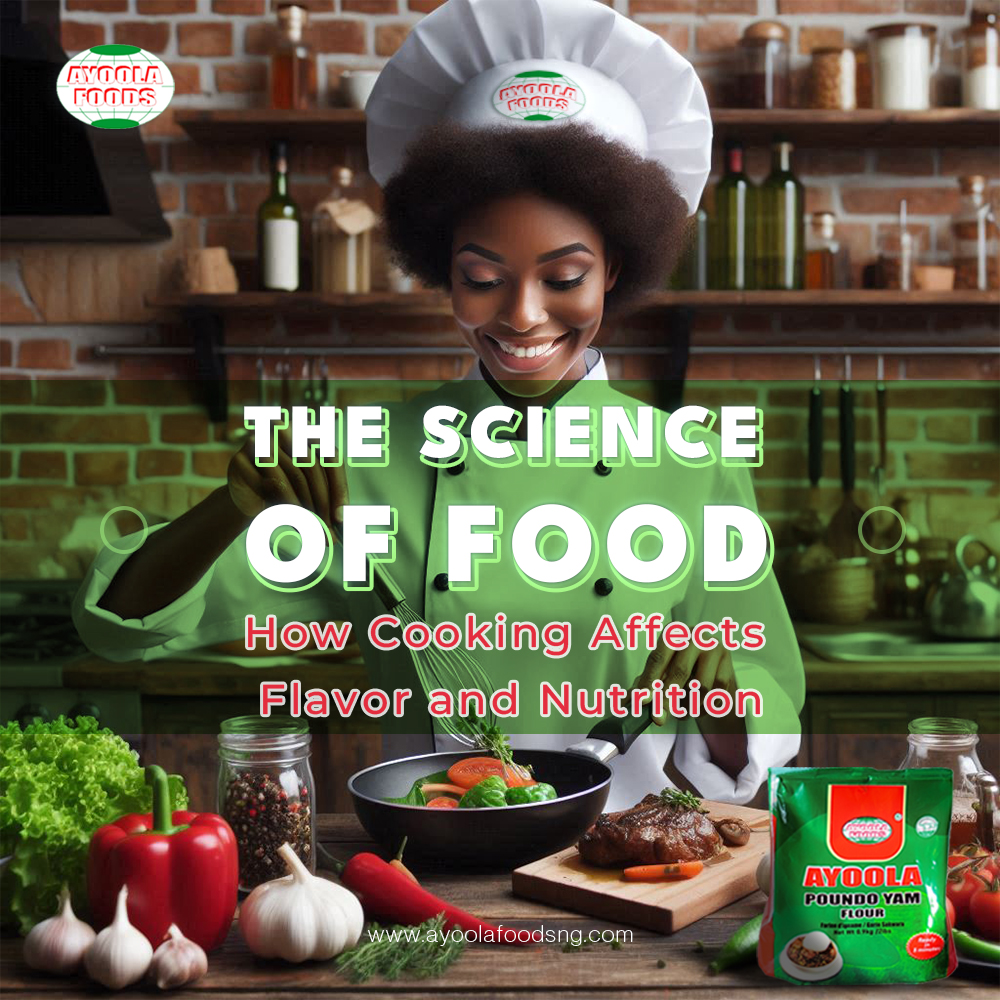
We all know that in Nigeria, food is more than just sustenance-it’s a significant part of our culture, traditions, and identity. Whether it’s the sizzling akara balls frying in oil, the fluffiness of Ayoola Poundo Yam forming easily with every turn, or the rich aroma of egusi soup simmering on the stove,or, cooking transforms ingredients into the delicious dishes we enjoy. But have you ever wondered how cooking changes the taste and nutritional value of our food?
Cooking, whether by boiling, frying, grilling, or roasting, triggers chemical reactions that can enhance or reduce both flavor and nutrition. In this article, we will go through how these processes work and what they mean for the food we love.
The Chemistry of Flavor
Cooking food involves heat, which causes a range of chemical reactions. One of the most important reactions is called the Maillard reaction. This occurs when amino acids (the building blocks of proteins) react with sugars at high temperatures. It’s responsible for the browning and complex flavors you taste in roasted meats, baked bread, or even the crispy edges of fried plantain. The Maillard reaction adds depth and richness to food, making it more savory and appetizing.
Another key process is caramelization. When sugar is heated, it breaks down and transforms into a golden-brown color, releasing sweet, nutty flavors. This happens when making caramel for desserts or even when grilling onions for stews. Caramelization brings out the natural sweetness in foods like tomatoes, onions, and peppers, adding layers of flavor to dishes like Nigerian pepper soup or asun (spicy grilled goat).
How Cooking Affects Nutritional Value
While cooking enhances flavor, it can have mixed effects on nutrition. Some nutrients are sensitive to heat and can be lost during cooking, while others become more accessible or easier to digest. Let’s break this down:
Enhanced Nutrient Availability: Cooking can increase the availability of certain nutrients. For instance, cooking tomatoes helps release lycopene, a powerful antioxidant that is more easily absorbed by the body after being heated. This is one reason why Nigerian stews and jollof rice, which often include cooked tomatoes, can be beneficial for your health.
Loss of Vitamins: On the other hand, heat can destroy some vitamins, particularly vitamin C and some B vitamins. For example, leafy vegetables like ugu (pumpkin leaves) and spinach may lose a significant portion of their vitamin C content when boiled for a long time. This is why steaming or lightly cooking vegetables is often recommended to preserve their nutrient content.
Protein Digestibility: Cooking also improves the digestibility of proteins, making them easier for the body to absorb. Proteins in beans, meats, and grains are often tightly packed in their raw state, but cooking them breaks down these structures, making them more accessible for digestion. This is important in Nigerian cuisine, where beans (in meals like moi moi) and various meats are dietary staples.
Impact of Cooking Methods: Different cooking methods have different effects on nutrition. Boiling, for example, can cause water-soluble nutrients to leach into the cooking water. This is why it’s often better to use the water from boiling (such as in soups) to avoid losing valuable nutrients. Grilling or roasting, on the other hand, can preserve more nutrients, but if food is overcooked or burnt, harmful compounds like acrylamides may form, which have been linked to health risks.
Frying, common in Nigerian dishes like puff-puff, dodo, and meat can add a lot of flavor but also significantly increases the calorie content. However, using healthier oil in moderation, can make a lot of difference in fried foods.
Balancing Flavor and Nutrition in Nigerian Cooking
Achieving a balance between flavor and nutrition in cooking is essential for a healthy diet. Here are a few tips to keep both in check:
Moderate frying: While fried foods are a staple, frying at lower temperatures and using less oil can reduce the formation of unhealthy compounds.
Cook vegetables lightly: Instead of overcooking vegetables, steam or stir-fry them to retain their nutrients while preserving flavor.
Use diverse cooking methods: Mix up your cooking methods. Grilling, steaming, and boiling in addition to frying helps balance flavor with health. For example, pairing roasted chicken with steamed greens like ugu or spinach creates a nutritious meal.
Include more raw ingredients: Incorporate more raw or lightly cooked foods like salads with cucumber, tomatoes, and avocado to retain nutrients that would otherwise be lost through cooking.
Conclusion
In Nigerian cuisine, cooking is an art form, but it’s also a science. The flavors we enjoy are the result of complex chemical reactions that happen during the cooking process. At the same time, heat changes the nutritional value of our food, sometimes for the better and sometimes not. By understanding how cooking affects both flavor and nutrition, we can make more informed choices in the kitchen—preparing meals that are not only delicious but also nourishing for our bodies.
Whether you’re making efo riro to eat with Ayoola Poundo Yam, or some party jollof rice, a balance between flavor and nutrition ensures that our beloved dishes remain a source of joy and health for generations to come.
For more on food and related topics, you can check our previous posts on the blog. Kindly drop your comments and share this post with others.
